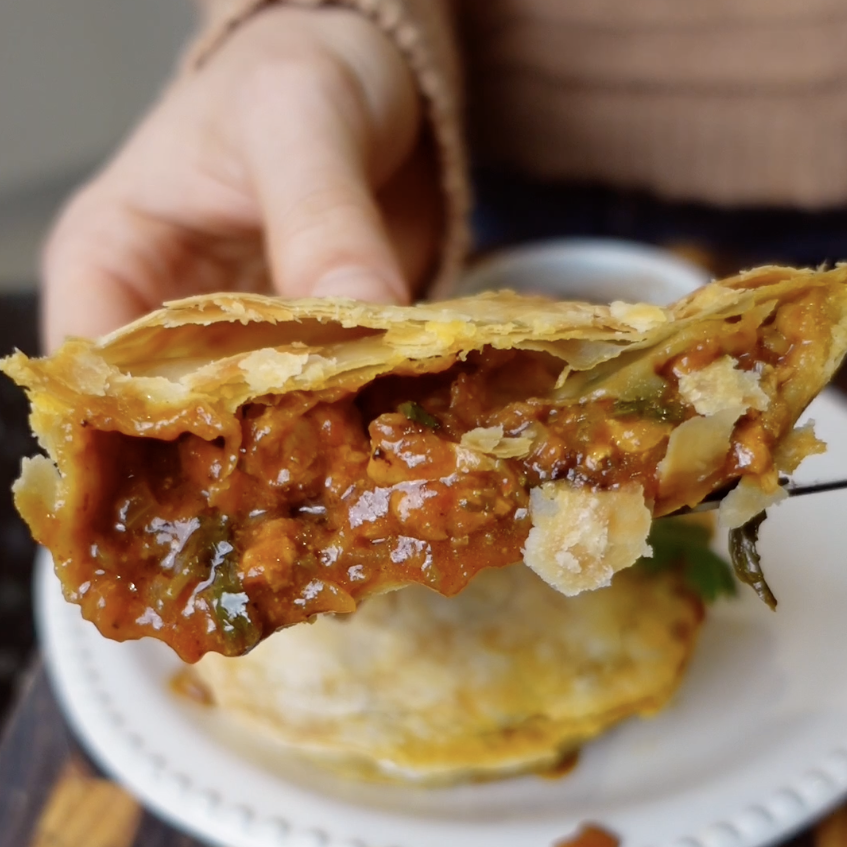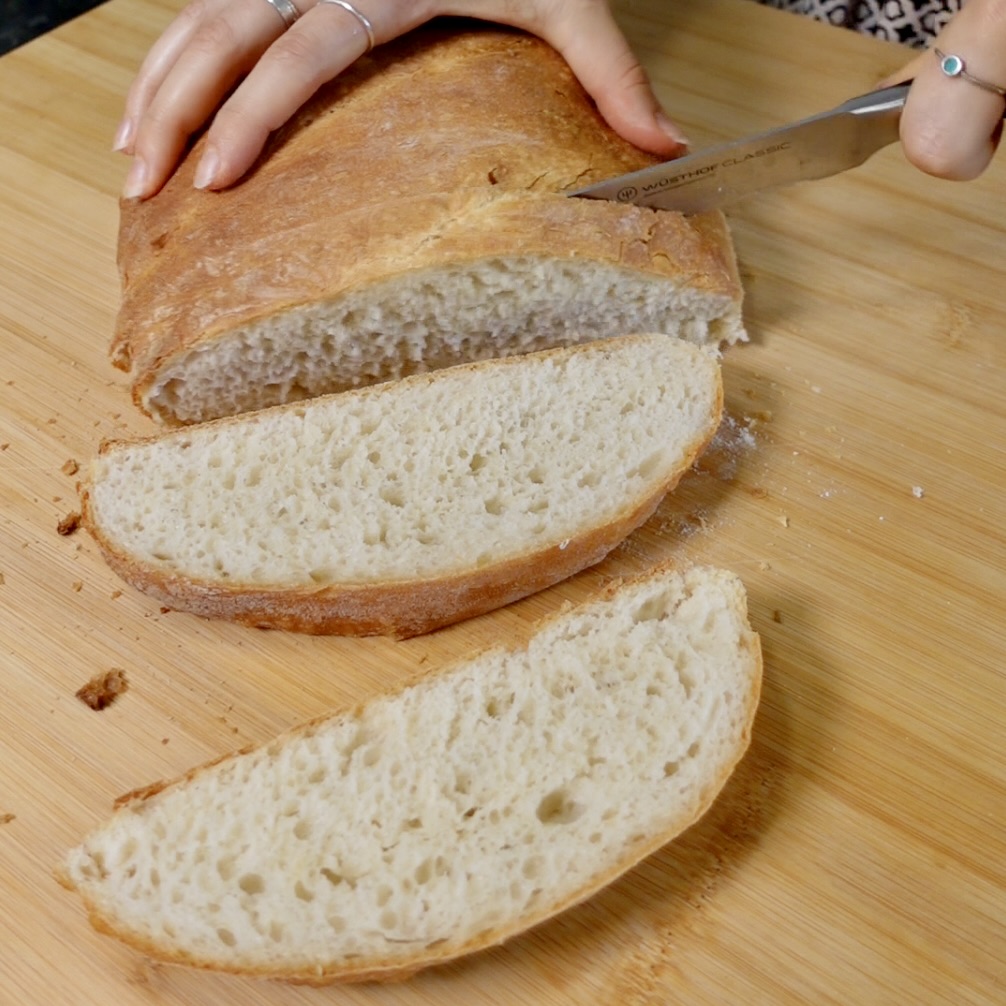
Sichuan Style Spicy Vegetable Stew
If you aren’t familiar with Sichuan cuisine, make this recipe your introduction to it. It’s packed full of salty, spicy and savoury flavours and is actually really easy to make. It’s a simple stew made with some quintessential Sichuan ingredients like Szechuan peppercorns, Doubanjiang and five spice powder.
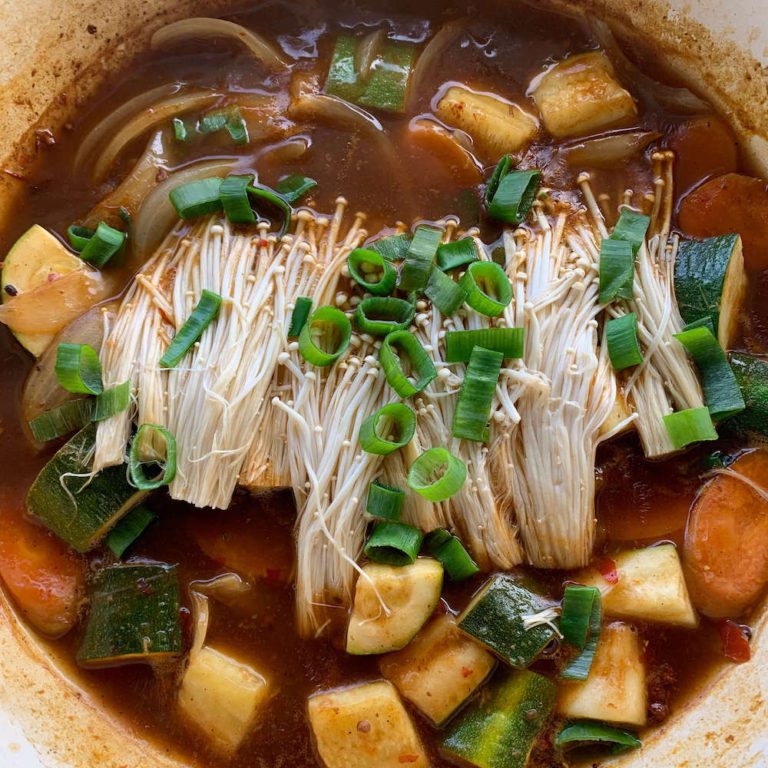
What Ingredients Do I Need To Make This Doubanjiang Vegetable Stew?
- Sichuan peppercorns
- Garlic
- Ginger
- Onions
- Five spice powder
- Shaoxing rice wine
- Doubanjiang, (Chinese fermented chili bean paste)
- Carrot
- Zucchini
- Chicken stock
- Soy sauce
- Sugar
- Rice wine vinegar
- Cornflour
- Enoki mushrooms
What is Doubanjiang?
Doubanjiang is a spicy Chinese paste made with chillies and fermented soybeans that is pretty integral to Sichuan cuisine. It has a unique salty, spicy and savoury taste that is similar to the Korean paste, Gochujang or even like a spicy miso paste. Because of it’s strong, distinct flavour, it works perfectly just mixed with some chicken stock to make a quick and easy soup.
Even if the name is unfamiliar to you, if you’ve ever eaten at a Sichuan restaurant, I can pretty much guarantee you’ve eaten it at some point in your life. Doubanjiang is a quintessential ingredient in dishes like Mapo Tofu, some variations of Dan Dan Noodles, Twice Cooked Pork, plus a whole bunch of stir fries, hot pots and stews.
How To Make This Sichuan Doubanjiang Vegetable Stew
STEP 1
Heat your saucepan over medium heat and add your oils. Once it’s hot, add your Sichuan peppercorns and toast them in the oil for a minute or 2 until they become fragrant. You can remove the peppercorns at this point if you’d like as they will fragrance the oil, but I like them left in.
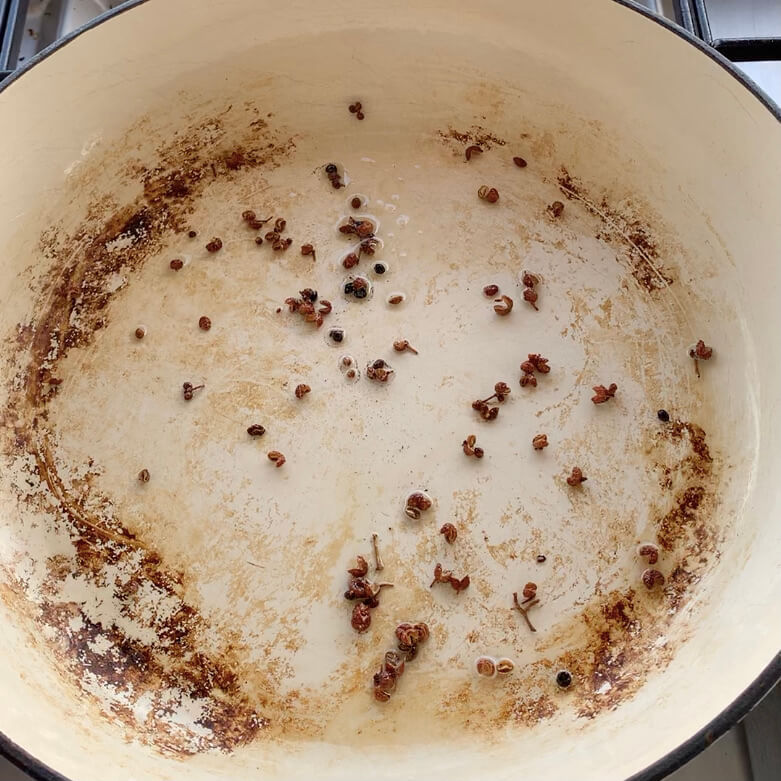
STEP 2
Add your onion, garlic, ginger and five spice and sauté until the onions are soft.
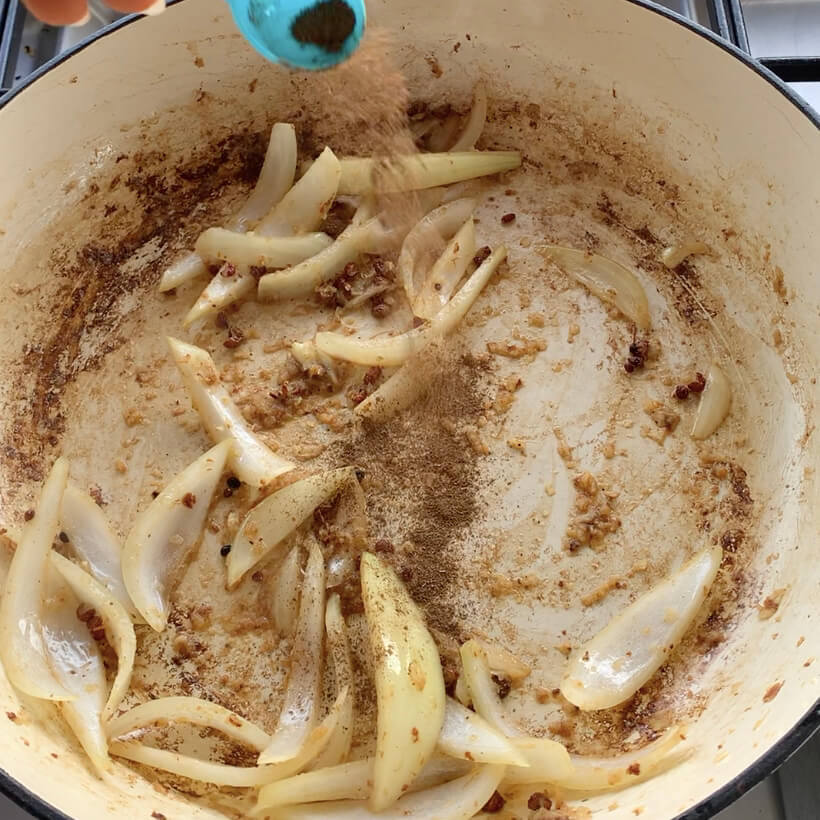
STEP 3
Deglaze with the Shaoxing wine, then add the Doubanjiang, carrots, zucchini, chicken stock, sugar and rice wine vinegar.
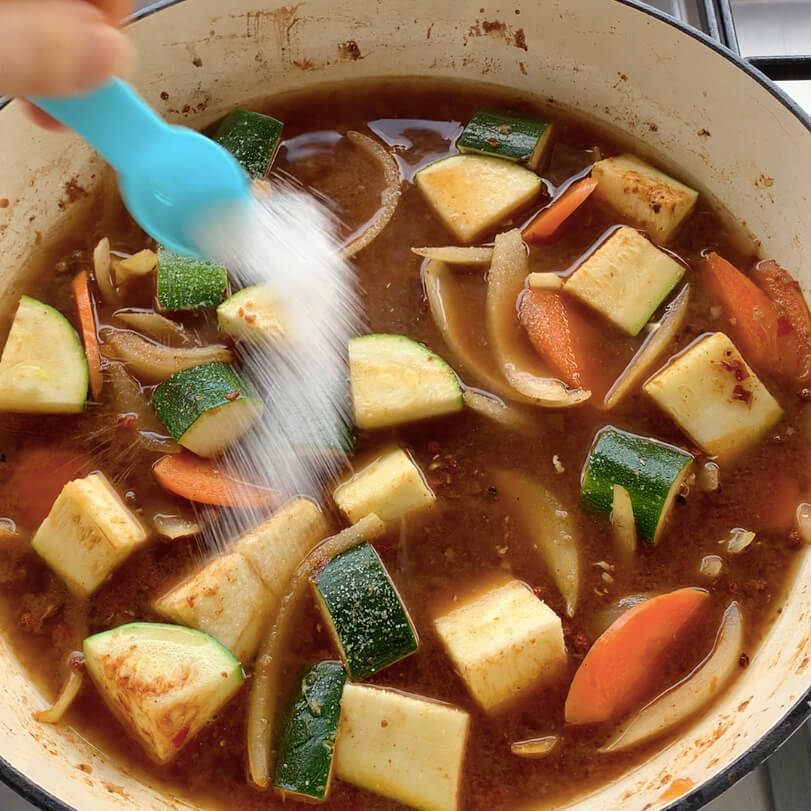
STEP 4
Leave that to simmer with the lid on for around 10 minutes to allow the vegetables to soften and the flavours to amalgamate. Taste the broth and adjust if necessary.
STEP 5
Mix your cornflour with a few tablespoons of water then pour into stew. Mix it thoroughly to evenly distribute the slurry and let it bubble for a few minutes so the broth becomes thick and glossy.

STEP 6
Break up your enoki into little bundles and add to the top of the stew. Turn the heat down and pop the lid back on for 5 minutes to soften the mushrooms.
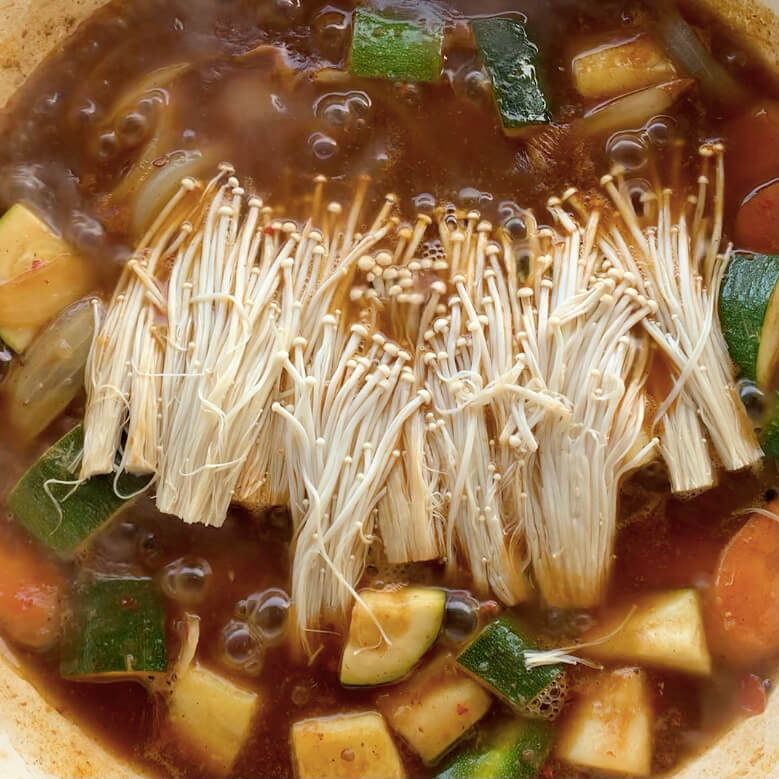
STEP 7
Sprinkle with chopped spring onion and sesame seeds and serve with rice.
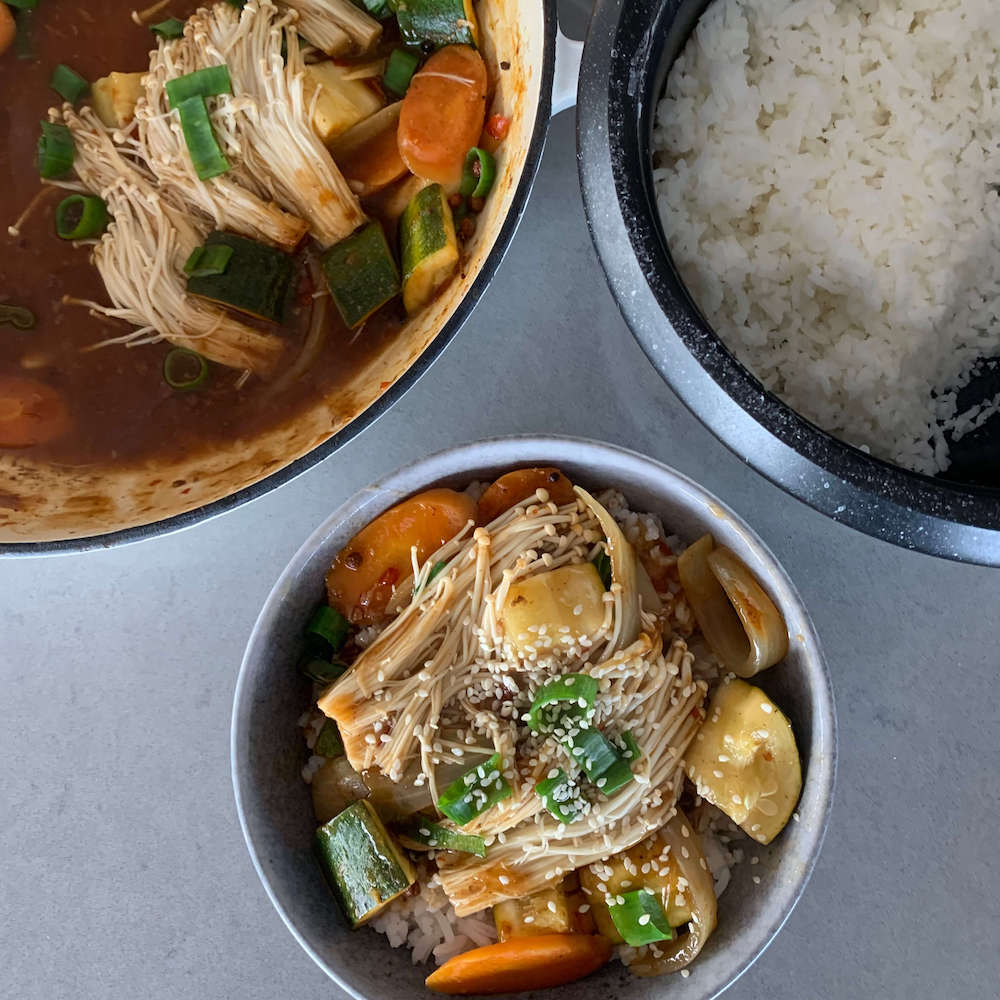
Substitutions and Variations to This Recipe
Meats – This recipe is pretty flexible and would be super receptive to the addition of different meats like chicken, beef, pork or even keep it vegetarian and add some tofu. You could use a tender cut like chicken breast or a fillet or you could simmer a cartilaginous cut in the broth for a few hours until tender before adding any of the vegetables.
Vegetables – I think this recipe needs a nice absorbent vegetable like zucchini or eggplant but other than that you can really use any vegetables you like. Try broccoli, cauliflower, peas, corn or beans.
Shaoxing rice wine – If you can’t get your hands on Shaoxing, try sherry, mirin or sake, or if you want an alcohol free alternative, just leave it out but add an extra tsp of rice vinegar.
Enoki Mushrooms – Personally, i love them but if you don’t like mushrooms, you can just leave them out. If you can’t find enokis specifically, use any other mushrooms, but just cook them for a little bit longer.
Doubanjiang – As this crux of this stew is the doubanjiang, there really isn’t any substitute for it. But if you want to make a variation of it, you can try Gochujang or miso with some form of chilli paste like sambal oelek or even siracha.
How Do I Store Any Leftovers?
This Sichuan Style Vegetable Stew will actually lend itself very well to being eaten the next day. Because this recipe uses some strong aromatics like five spice and Sichuan Peppercorns, and vegetables that suck up flavour like a sponge, the longer it sits in the fridge, the more those flavours will develop. You can store it in an airtight container for around 3 days in the fridge. I wouldn’t recommend freezing any leftovers though as the vegetables with break down and become mushy.
To reheat, simply microwave it for a few minutes or warm it up in a pot over the stove.
Recipe
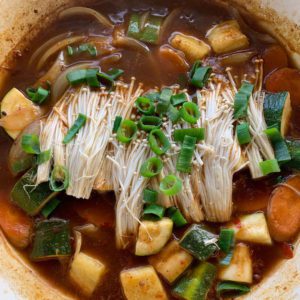
Sichuan Style Spicy Vegetable Stew
If you aren't familiar with Sichuan cuisine, make this recipe your introduction to it. It's packed full of salty, spicy and savoury flavours and is actually really easy to make. It's a simple stew made with some quintessential Sichuan ingredients like Szechuan peppercorns, Doubanjiang and five spice powder.
Prep Time 10 minutes mins
Cook Time 20 minutes mins
Servings 2
Ingredients
- 1 tbsp Oil
- ½ tsp Sesame oil
- 1 tsp Sichuan peppercorns
- 3 cloves Garlic minced
- 1 tbsp Ginger grated
- ½ Onion sliced
- ½ tsp Five spice powder
- 2 tbsp Shaoxing rice wine
- 2 tbsp Doubanjiang (Chinese fermented chili bean paste)
- 1 Carrot sliced
- 1 Zucchini 2cm dice
- 2 cups Chicken stock
- 1 tbsp Light soy sauce
- 2 tsp Sugar
- 2 tsp Rice wine vinegar
- 1 tbsp Cornflour
- 1 bunch Enoki mushrooms ends cut off
- Spring onions for garnish
- Sesame seeds for garnish
Instructions
- Heat your saucepan over medium heat and add your oils. Once it's hot, add your Sichuan pepper corns and toast them in the oil for a minute or 2 until they become fragrant. You can remove the peppercorns at this point if you'd like as they will fragrance the oil, but I like them left in.
- Add your onion, garlic, ginger and five spice and sauté until the onions are soft.
- Deglaze with the Shaoxing wine, then add the Doubanjiang, carrots, zucchini, chicken stock, soy sauce, sugar and rice wine vinegar.
- Leave that to simmer with the lid on for around 10 minutes to allow the vegetables to soften and the flavours to amalgamate. Taste the broth and adjust if necessary.
- Mix your cornflour with a few tablespoons of water then pour into stew. Mix it thoroughly to evenly distribute the slurry and let it bubble for a few minutes so the broth becomes thick and glossy.
- Break up your enoki into little bundles and add to the top of the stew. Turn the heat down and pop the lid back on for 5 minutes to soften the mushrooms.
- Sprinkle with chopped spring onion and sesame seeds and serve with rice.
OTHER RECIPES YOU’LL LOVE!

Hey! I’m Montana...
Mon Mack Food is my little space to share my passion for food. It is also a place to document the recipes I’ve created while cooking for friends and family! While it is now just a hobby, my absolute dream is to build this project into something I can one day call my job 🙂



